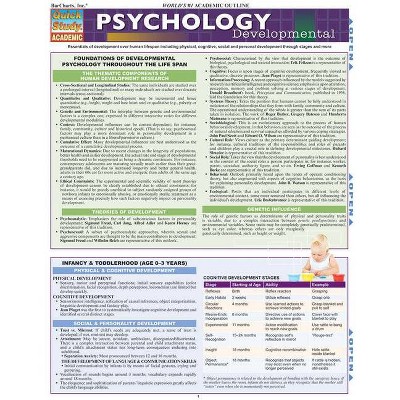Developmental Psychology - (Introductory) 3rd Edition,Large Print by Connor Whiteley (Paperback)

Similar Products
Products of same category from the store
AllProduct info
<p/><br></br><p><b> Book Synopsis </b></p></br></br><p>Do you want to learn about child development?</p><p>Do you want to learn how a child develops cognition, language and more? </p><p>Do you want an easy to understand and engaging guide to developmental psychology? </p><p>If the answer is yes, then this is the book for you as in this book you will learn about a wide range of topics in developmental psychology. </p><p>By the end of this book, you will know: </p><ul><li>What developmental psychology is?</li><li>What is Attachment, its Types and How it Develops?</li><li>How Language Develops?</li><li>How Our Cognition and Brains Develop?</li><li>And More...</li></ul><p>BUY TODAY TO START LEARNING ABOUT DEVELOPMENTAL PSYCHOLOGY! </p><p>Developmental Psychology Second Edition Content: </p><p>Introduction </p><p>Chapter 1: Introduction to Developmental Psychology and Modern Theories</p><p>Chapter 2: Research Methods in Developmental Psychology</p><p>Chapter 3: The Perceived Link Between Autism and the MMR Vaccine</p><p><br></p><p>Part 1: Brain and Cognitive Development</p><p>Chapter 4: Brain Development</p><p>Chapter 5: Cognitive Development</p><p>Chapter 6: Introduction to Theory of Mind</p><p><br></p><p>Part 2: The Self Concept, Gender Identity, Attachment and Peers and Play</p><p>Chapter 7: Development of The Self Concept</p><p>Chapter 8: Gender Identity</p><p>Chapter 9: Introduction to Attachment</p><p>Chapter 10: Acquiring Attachment and Attachment Types</p><p>Chapter 11: Feelings, Relationships and Types of Attachment</p><p>Chapter 12: Introduction to Peers and Play</p><p>Chapter 13: Peers and Play</p><p>Chapter 14: Pretend or Symbolic Play</p><p>Chapter 15: Pretend Play, Creativity, Scaffolding, Role-Taking and Imaginary Friends </p><p>Chapter 16: Technology, Play and Final Notes</p><p>Chapter 17: What is Dramatherapy?</p><p><br></p><p>Part Three: Culture, Poverty and Trauma</p><p>Chapter 18: Cross-Cultural Development</p><p>Chapter 19: Poverty</p><p>Chapter 20: Trauma and Childhood Resilience </p><p><br></p><p>Part 4: Language Development</p><p>Chapter 21: Introduction to Language Development</p><p>Chapter 22: Theories of Language Development</p><p>Chapter 23: Pragmatic Language and What Influences Language Development?</p><p><br></p><p>Part 5: Sensory Development</p><p>Chapter 24: Sensory Development and the Development of Vision</p><p>Chapter 25: Cognitive Development of Facial Processing</p><p><br></p><p>Part 6: Development of Prosocial Behaviour</p><p>Chapter 26: Introduction to the Development of Prosocial Behaviour</p><p>Chapter 27: Toddlers, Helping Behaviour and Sharing</p><p>Chapter 28: Take Home Message, Finetuning Factors and Prosocial Behaviour in Other Species</p><p><br></p><p>Part 7: Child and The Media</p><p>Chapter 29: Introduction to the Media</p><p>Chapter 30: Can Children learn From Video?</p><p>Chapter 31: Pre-schoolers and TV</p><p>Chapter 32: Overall Do Children Learn from Screen Media?</p><p><br></p><p>Part 8: Adolescence</p><p>Chapter 33: Adolescence and Biological Transition</p><p>Chapter 34: Cognitive Transition </p><p>Chapter 35: Social Time and Friendship Changes in Adolescence</p><p>Chapter 36: Romantic Relationships, Conflict with Parents and Autonomy</p><p>Chapter 37: Personality, Identity and Self Development</p><p><br></p><p>Part 9: Atypical Development</p><p>Chapter 38: Atypical Development</p><p>Chapter 39: Williams Syndrome </p><p>Chapter 40: Autism Spectrum Conditions</p><p>Chapter 41: Development of Metacognition: A Guide to Metacognition, Metamemory, More and Its Importance</p>
Price History
Price Archive shows prices from various stores, lets you see history and find the cheapest. There is no actual sale on the website. For all support, inquiry and suggestion messagescommunication@pricearchive.us




















